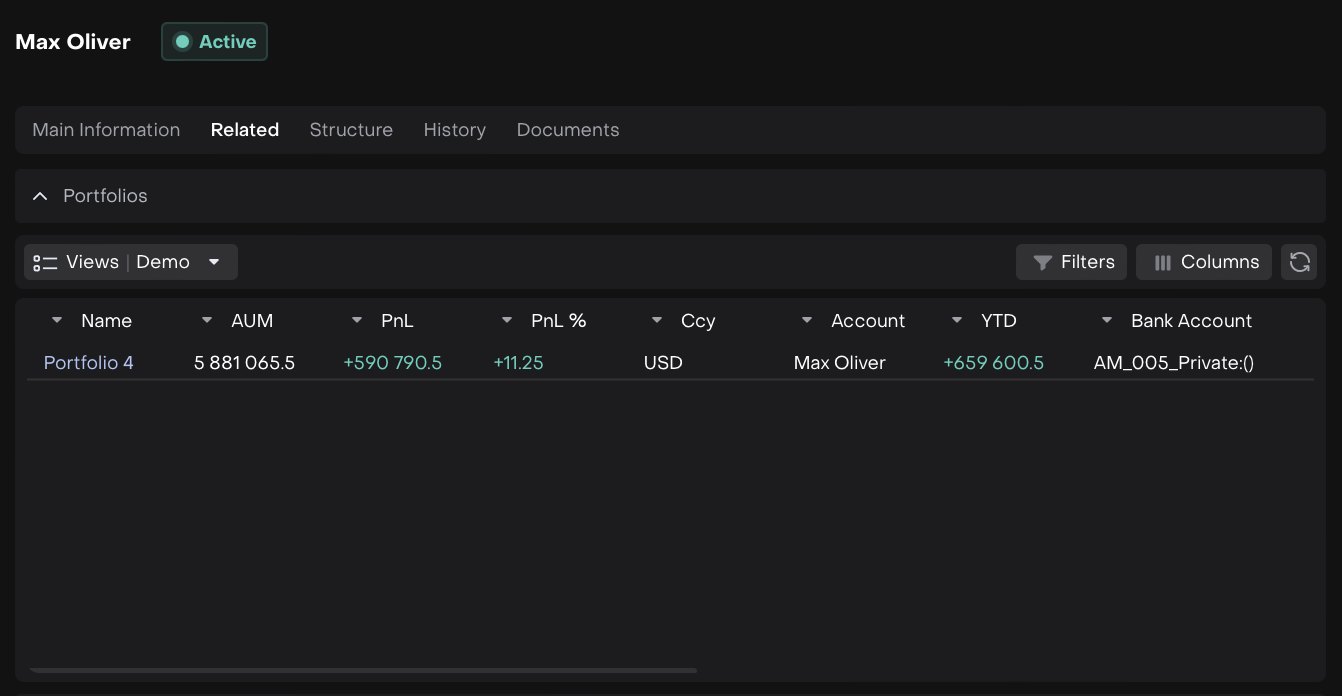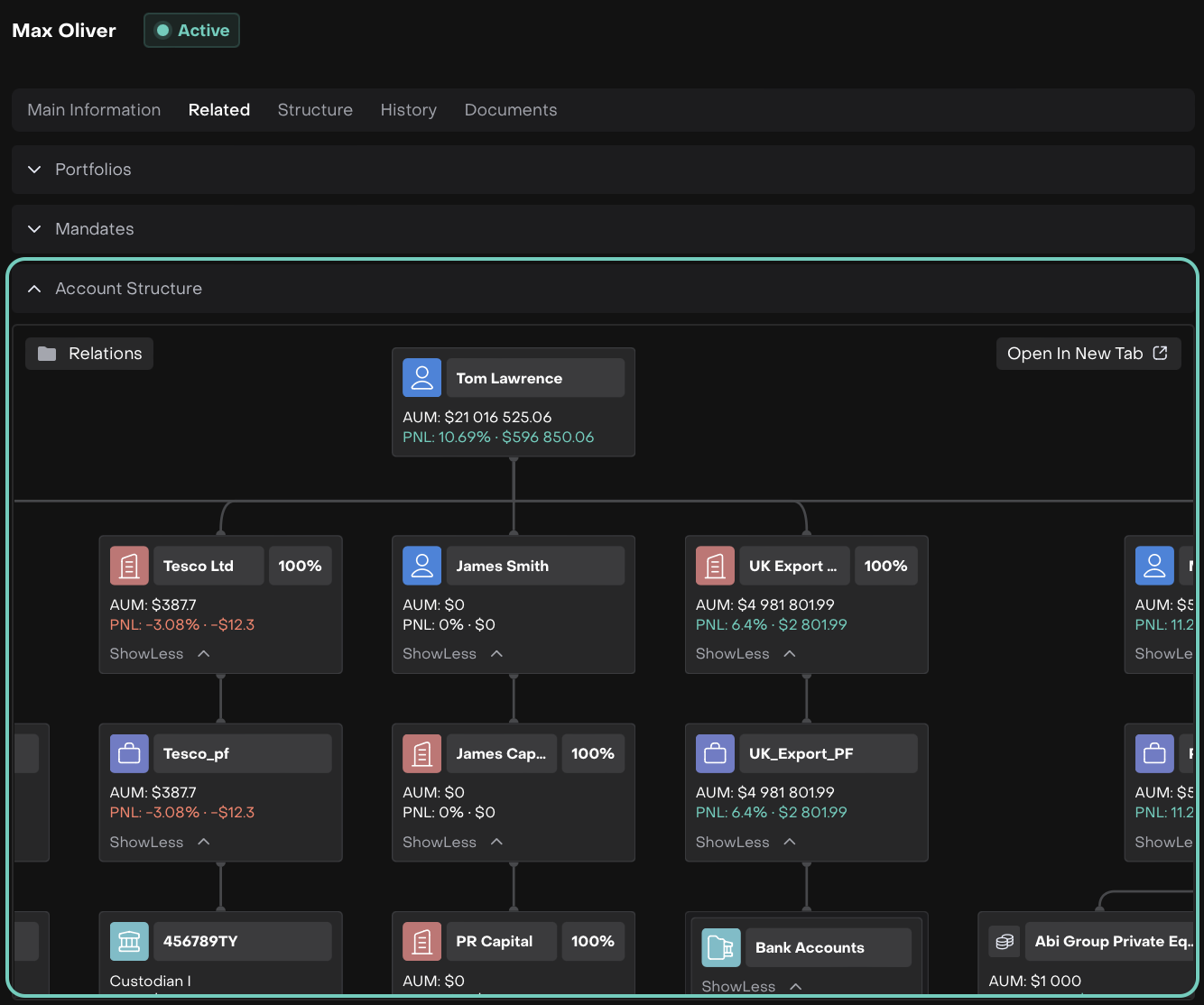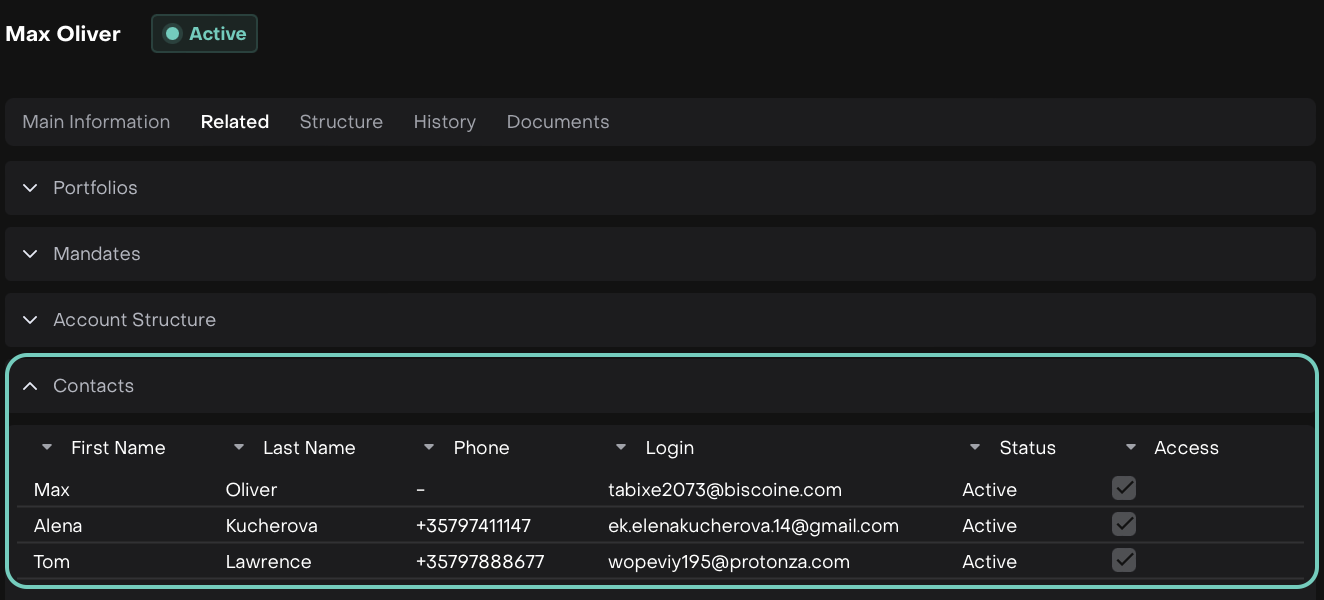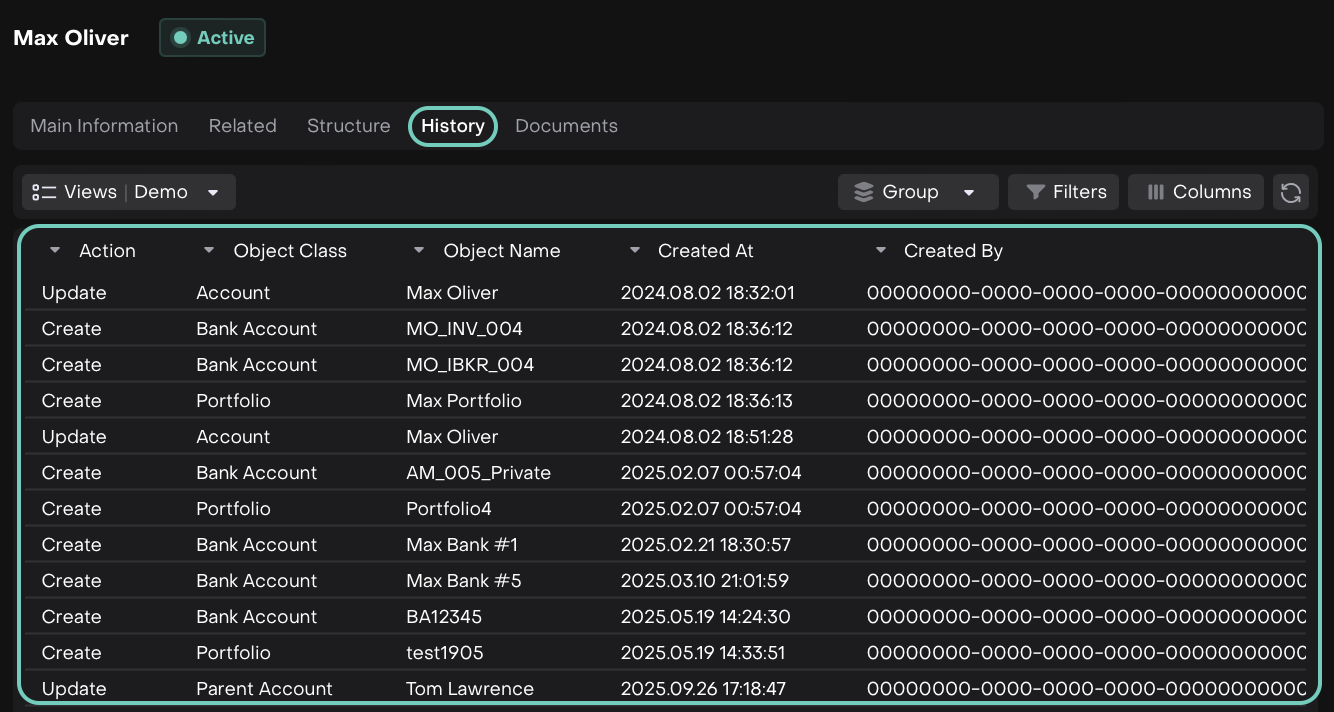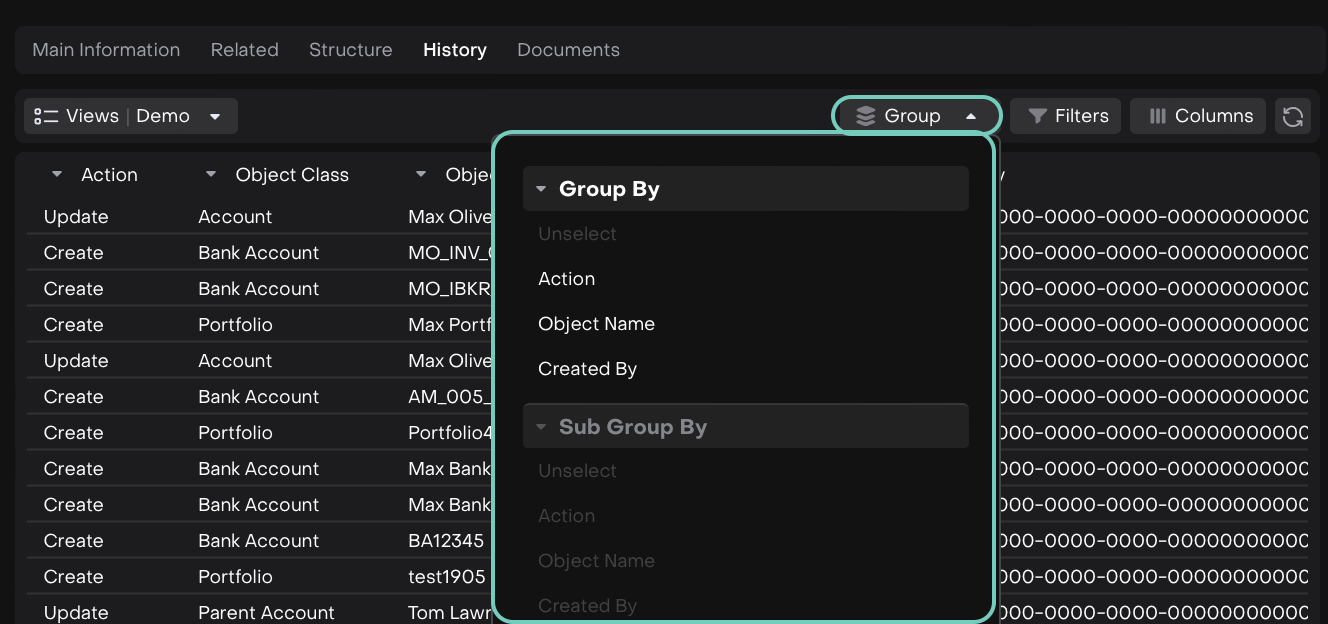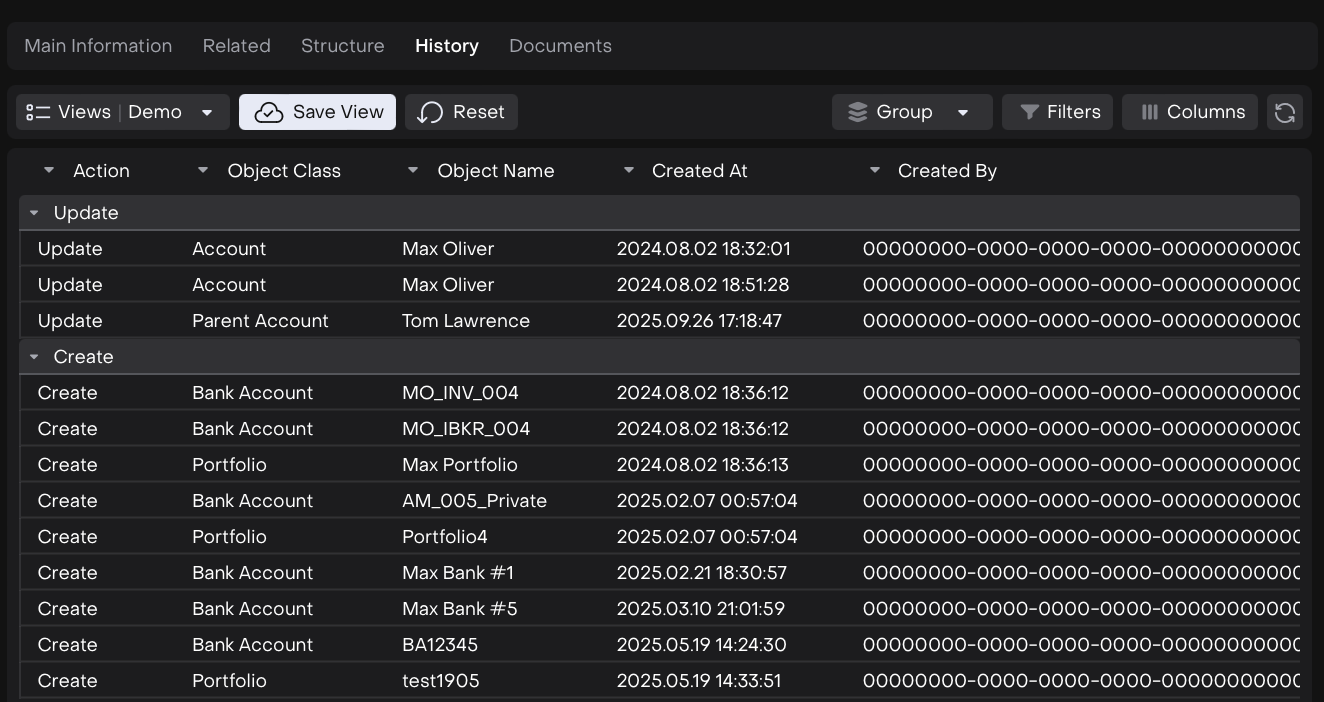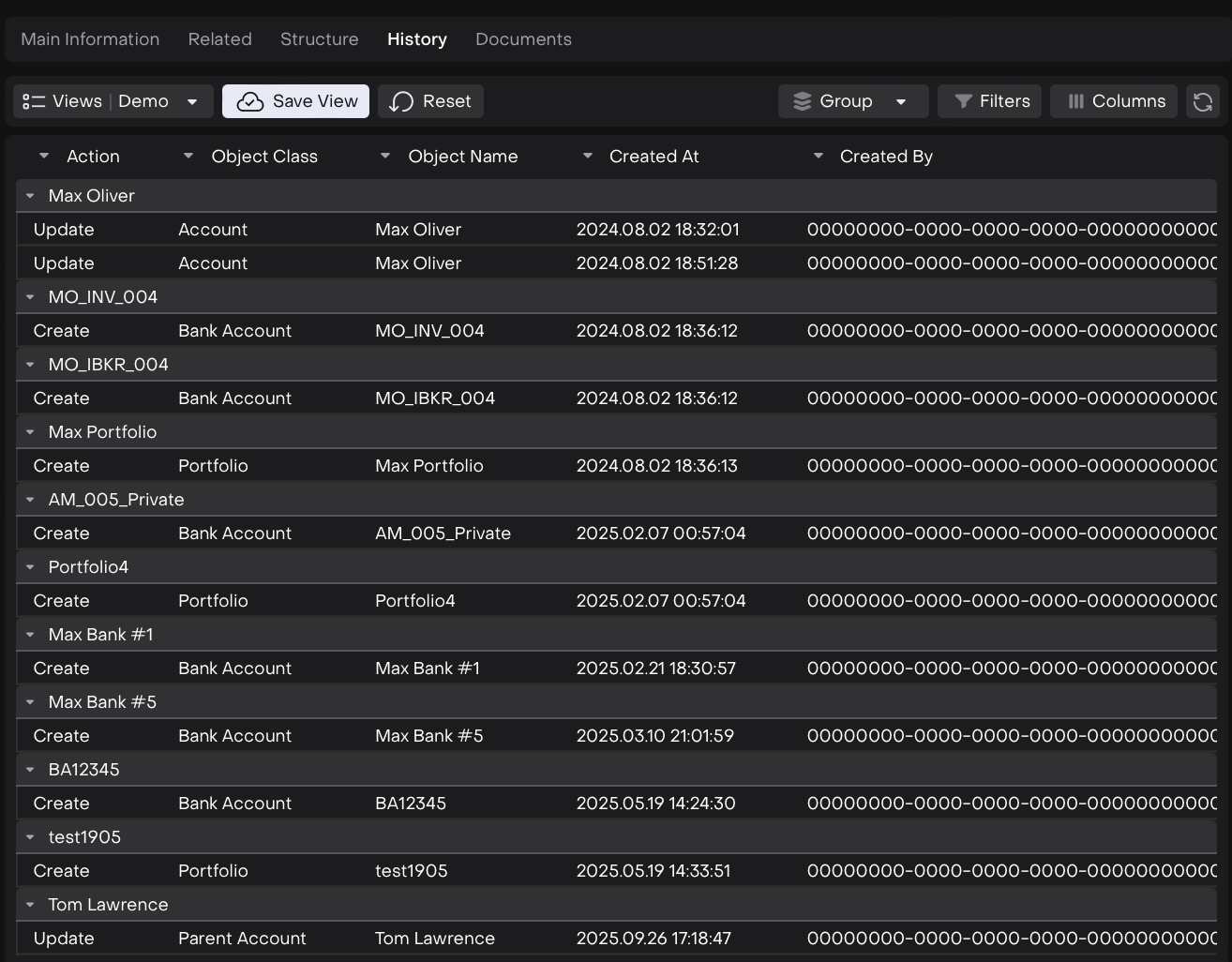Introduction The Accounts tab is where you can manage all your accounts within the platform. It provides a centralized view of every client, company or entity account you manage, along with key details like registration numbers, ownership type, risk levels and more.
The tab is divided into three main sections:
Accounts – Displays all your accounts.
Bank Accounts – Lists all linked bank accounts.
Account Structure – Shows the hierarchical structure of related accounts.
You can view, filter and organize your accounts effortlessly using advanced settings to focus on the information that matters most to you.
🔗 Click here filter accounts using Advanced Settings .
Key Terminologies Term (A-Z)
Definition
Bank Account
The linked bank account for transactions and settlements.
Portfolio
A collection of investments associated with the account.
Cash
Total available cash balance in a portfolio.
AUM (Assets Under Management)
Total market value of assets in a portfolio.
PnL (Profit and Loss)
Total gain or loss in a portfolio.
PnL % (Profit and Loss Percentage)
Portfolio’s gain or loss as a percentage of its value.
MTD (Month-to-Date Performance)
Portfolio’s performance since the start of the month.
YTD (Year-to-Date Performance)
Portfolio’s performance since the start of the year.
Access
Indicates if a contact can log in to the platform.
Main
Marks the primary contact for the account.
Role
Relationship of a person to the account (e.g., Beneficial Owner, Director).
Ownership, %
Percentage of ownership or control held by a person.
Content Type
Type of uploaded document (PDF, Word, Image).
Manage Accounts Main Info View the core account details, including account type, ownership structure, registration information, and risk classification and much more.
Access related entities connected to the account, such as:
Related Tab – Portfolios Table Reference
Column Name (A–Z)
Definition
How It’s Used on the Platform
Account
The client or entity account associated with the portfolio.
Identifies which account owns or manages the portfolio.
AUM (Assets Under Management)
The total market value of assets currently managed within the portfolio.
Helps assess the overall portfolio size and investment exposure.
Bank Account
The bank account linked to the portfolio for transactions and settlements.
Ensures all trades, deposits, and withdrawals are processed through the correct financial account.
Cash
The total available cash balance within the portfolio.
Used to determine available liquidity for new investments or withdrawals.
Consolidated Portfolios
Indicates whether the portfolio is part of a consolidated (grouped) portfolio view.
Helps users view combined portfolio data when multiple portfolios are managed together.
Created At
The date and time when the portfolio was created on the platform.
Useful for tracking portfolio creation history.
Created By
The user or system ID that created the portfolio record.
Displays who initiated the creation of the portfolio.
Ccy (Currency)
The operating currency of the portfolio (e.g., USD, EUR).
Determines the base currency used for valuation and reporting.
MTD (Month-to-Date Performance)
The cumulative profit or loss for the portfolio since the start of the current month.
Used to track short-term performance trends and compare monthly returns.
PnL (Profit and Loss)
The total realized and unrealized gain or loss in the portfolio.
Measures overall portfolio performance over time.
PnL % (Profit and Loss Percentage)
The profit or loss expressed as a percentage of the initial or current portfolio value.
Quickly shows how well the portfolio is performing in percentage terms.
Portfolio Status
Indicates the current operational status of the portfolio (e.g., Active, Deactivated).
Helps track whether the portfolio is currently active or not.
Updated At
The date and time when the portfolio details were last modified.
Tracks the most recent update to portfolio information.
Updated By
The user who last edited or updated the portfolio.
Displays who made the most recent change.
YTD (Year-to-Date Performance)
The cumulative profit or loss for the portfolio since the start of the current year.
Used to measure annual performance trends and investment growth.
Related Tab – Mandates Table Reference
Column Name (A–Z)
Definition
How It’s Used on the Platform
agreementNumber
A unique identifier assigned to the mandate agreement.
Helps track and reference the specific mandate linked to the account.
authorizedPersons
Lists the individuals who have the authority to act on behalf of the mandate.
Used to verify and manage access or decision-making permissions for the mandate.
name
The name or title of the mandate.
Helps users easily identify the mandate in the list.
status
Indicates the current state of the mandate (e.g., Active, Deactivated).
Allows users to monitor the operational validity and lifecycle of each mandate.
Related Tab – Contacts Table Reference
Column Name (A–Z)
Definition
How It’s Used on the Platform
Access
Indicates whether the contact has access to the platform.
Helps identify which contacts can log in and interact with the platform.
Email
The email address associated with the contact.
Used for communication, login credentials, and notifications.
First Name
The given name of the contact.
Displays the primary identifier of the contact.
Last Name
The surname or family name of the contact.
Complements the first name for full identification.
Login
The username or ID used by the contact to access the platform.
Enables authentication and tracking of individual user activity.
Main
Indicates if the contact is marked as the primary point of contact.
Helps distinguish the key contact person among multiple entries.
Phone
The contact’s phone number.
Used for direct communication or verification purposes.
Status
Shows whether the contact is Active or Inactive.
Allows users to manage contact availability and access.
Last Login
The most recent date and time the contact accessed the platform.
Helps track user engagement and identify inactive users.
Structure Tab Visualize the account’s structure — including parent and subsidiary relationships — to understand the hierarchy between accounts.
Structure (Controlling Persons) Table Reference:
Column Name (A–Z)
Definition
How It’s Used on the Platform
Address
The residential or registered address of the controlling person.
Provides location details for identification and compliance checks.
Country of Residency / Registration
The country where the person resides or is officially registered.
Used for regulatory reporting, tax compliance, and KYC requirements.
Name
The given or first name of the controlling person.
Identifies the individual associated with account ownership or control.
Ownership, %
The percentage of ownership or control held by the person.
Helps determine the person’s share or influence in the account or entity.
Role
The person’s relationship to the account. Options are:
BENEFICIAL_OWNER
BENEFICIARY
DIRECTOR
PROTECTOR
SECRETARY
SETTLOR
TRUSTEE
Defines the individual’s level of authority or responsibility.
Surname
The last name of the controlling person.
Complements the Name field for complete identification.
Type of Person
Specifies whether the controlling person is Legal or Natural .
Used to classify and distinguish between personal and corporate ownership.
History Tab Track changes, updates and actions taken on the account over time.
History Tab Table Reference:
Column Name (A–Z)
Definition
How It’s Used on the Platform
Action
Type of action performed on the object (e.g., Create, Update, etc).
Tracks changes or creation of accounts, portfolios, and related objects for audit purposes.
Created At
Timestamp when the action was performed.
Provides historical reference to monitor when updates or creations occurred.
Created By
User who performed the action.
Maintains accountability and allows tracking of user activity.
Object Class
The type of object impacted by the action (e.g., Account, Bank Account, Portfolio).
Helps identify which kind of object was affected for reporting or auditing.
Object Name
The specific name of the object affected.
Shows exactly which account, portfolio, or bank account was changed or created.
Workflow Status
Current status of the workflow associated with the object (if any).
Provides insight into whether the object’s processing is pending, approved, or completed.
Workflow Status Reason
The reason or explanation for the workflow status.
Helps users understand why a workflow is in its current state (e.g., rejected, pending approval).
Advanced Settings for History Tab:
Group By:
Action - Groups records by the type of action (Create, Update, Delete).
Object Name - Groups records by the affected object’s name (Account, Portfolio, etc.).
Created By - Groups records by when the user performed the action.
Grouped By Action View
Grouped By Object Name View
Grouped By Created By View
Filters:
Allow you to narrow down your search based on fields type, specific criteria and more.
🔗 Learn more here
Documents Tab View or download supporting documents, such as identification proofs, registration certificates and compliance records.
Documents Tab Table Reference:
Column Name (A–Z)
Definition
How It’s Used on the Platform
Content Type
Type of the document (e.g., PDF, Word, image).
Helps you identify the format of the document for viewing or downloading.
Created At
Timestamp when the document was uploaded or added.
Provides a historical reference of when a document was attached.
Created By
User who uploaded the document.
Maintains accountability and tracks who added the document.
File Name
Name of the uploaded document.
Lets you identify and locate specific documents easily.
Updated At
Timestamp of the most recent update to the document.
Shows when the document was last modified for version tracking.
Updated By
User who last updated the document.
Tracks accountability for edits and updates made to documents.




